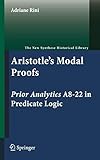Aristotle's Modal Proofs : Prior Analytics A8-22 in Predicate Logic / by Adriane Rini.
Tipo de material: TextoSeries The New Synthese Historical Library ; 68Editor: Dordrecht : Springer Netherlands, 2011Descripción: vI, 246 páginas recurso en líneaTipo de contenido:
TextoSeries The New Synthese Historical Library ; 68Editor: Dordrecht : Springer Netherlands, 2011Descripción: vI, 246 páginas recurso en líneaTipo de contenido: - texto
- computadora
- recurso en línea
- 9789400700505
- B108-5802
Springer eBooks
Acknowledgements -- Introduction -- Part I: Modern Methods for Ancient Logic -- 1. The Non-Modal Syllogistic: An.Pr. A1-7 -- 2. The Assertoric Syllogistic in LPC -- 3. A Realm of Darkness -- 4. Technicolour Terms -- 5. Representing Modality -- Part II: Necessity in the Syllogistic: An. Pr. 8-12 -- 6. Syllogizing in Red: Trivializing the Modals -- 7. First-Figure Mixed Apodeictic Syllogisms -- 8. Modal Conversion in the Apodeictic Syllogistic -- 9. Against the Canonical Listings -- 10. Apodeictic Possibility -- Part III: Contingency in the Syllogistic: An. Pr. 13-22 -- 11. Contingency (A13, A14) -- 12. Realizing Possibilities -- 13. Barbara XQM -- 14. First Figure X+Q (A15) -- 15. First Figure L+Q, Q+L (A16) -- 16. Contingency in the 2nd Figure (A17, A18, A19) -- 17. Contingency in the 3rd Figure (A20, A21, A22) -- 18. Summary and Conclusion -- Appendix: The LPC Framework -- Bibliography -- Index.
Aristotle’s modal syllogistic is his study of patterns of reasoning about necessity and possibility. Many scholars think the modal syllogistic is incoherent, a ‘realm of darkness’. Others think it is coherent, but devise complicated formal modellings to mimic Aristotle’s results. This volume provides a simple interpretation of Aristotle’s modal syllogistic using standard predicate logic. Rini distinguishes between red terms, such as ‘horse’, ‘plant’ or ‘man’, which name things in virtue of features those things must have, and green terms, such as ‘moving’, which name things in virtue of their non-necessary features. By applying this distinction to the Prior Analytics, Rini shows how traditional interpretive puzzles about the modal syllogistic melt away and the simple structure of Aristotle’s own proofs is revealed. The result is an applied logic which provides needed links between Aristotle’s views of science and logical demonstration. The volume is particularly valuable to researchers and students of the history of logic, Aristotle’s theory of modality, and the philosophy of logic in general.
Para consulta fuera de la UANL se requiere clave de acceso remoto.


